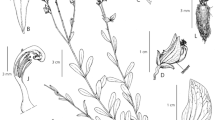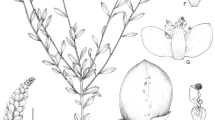Abstract
Polygala brasiliensis Mart., Polygala carlotina E.H.L. Krause, Polygala paniculata f. leucoptera S.F. Blake, Polygala ramosissima Cav. (POWO 2020)
Similar content being viewed by others
References
Arnold A, Harijanto H, Sustri S. Keanekaragaman jenis dan pemanfaatan tumbuhan obat di kawasan Taman Nasional Lore Lindu (TNLL) di Desa Mataue Kecamatan Kulawi Kabupaten Sigi. Warta Rimba. 2017;5(1):71–9.
Badrunasar A, Santoso HB. Tumbuhan liat berkhasiat obat. Bogor: FORDA Press; 2016.
Batoro J, Siswanto D. Ethnomedicinal survey of plants used by local society in Poncokusumo district, Malang, East Java Province, Indonesia. Asian J Med Biol Res. 2017;3(2):158–67.
Bettio L, Machado G, Cunha MP, Capra JC, Missau FC, Santos RS, et al. Antidepressant-like effect of extract from Polygala paniculata: involvement of the monoaminergic systems. Pharm Biol. 2011;49(12):1277–85. https://doi.org/10.3109/13880209.2011.621958.
Chen SH, Ma H, JAN P. Polygalaceae. In: Wu ZY, Raven PH, Hong DY, editors. Flora of China, Oxalidaceae through Aceraceae, vol. 11. Beijing/St. Louis: Science Press/Missouri Botanical Garden Press; 2008. p. 139–59.
Cristiano R, Pizzolatti MG, Monache FD, Rezende CM, Branco A. Two xanthones from Polygala paniculata and confirmation of the 1-hydroxy- 2,3,5-trimethoxy-xanthone at trace level by HRGC-MS. Z Naturforsch C. 2003;58(7–8):490–4. https://doi.org/10.1515/znc-2003-7-808.
Farina M, Franco JL, Ribas CM, Meott FVC, Missau FC, Pizzolatti MG, et al. Protective effects of Polygala paniculata extract against methylmercury-induced neurotoxicity in mice. J Pharm Pharmacol. 2005;57(11):1503–8. https://doi.org/10.1211/jpp.57.11.0017.
Firison J, Ishak A, Hidayat T. Utilization of understorey on palm oil stands by local community (Case of Kungkai Baru Village, Air Periukan Subdistrick, Seluma Regency – Bengkulu). Agritepa. 2018;5(1):19–31.
Hamburger M, Hostettmann K, Stoeckli-Evans H. A new pyranocoumarin diester from Polygala paniculata L. Helv Chim Acta. 1984;67:1729–33. https://doi.org/10.1002/hlca.19840670710.
Hamburger M, Gupta M, Hostettmann K. Coumarins from Polygala paniculata. Planta Med. 1985;51(03):215–7. https://doi.org/10.1055/s-2007-969460.
Handayani M, Sari SG, Kuntorini EM. An ethnobotany of understory species in the Loksado protected forest, South Kalimantan. In: International conference on natural mathematical and environmental sciences for sustainable development. Banjarbaru: Faculty of Mathematics and Natural Sciences; 2015. p. 38–45.
Hidayat S. Existence of endangered medicinal plant and its uses in Bogor surrounding areas. Media Konserv. 2012;17(1):33–8.
Irwanto RRP. Polygala L. [Internet] record from proseabase. In van Valkenburg JLCH, Bunyapraphatsara N, editors. PROSEA (Plant resources of South-East Asia) Foundation, Bogor, Indonesia. 2001. http://www.proseanet.org. Accessed 3 May 2020.
Iswandono E, Zuhud EAM, Hikmat A, Kosmaryandi N. The ethnobotany knowledge of Manggarai Tribe and the implication utilization of forest plants in the Mountains of Ruteng. Jurnal Ilmu Pertanian Indonesia. 2015;20(3):171–81. https://doi.org/10.18343/jipi.20.3.171.
Kusuma NA, Suryani T. Exploration of medicinal plants in natural forest area Girimanik Setren Subdistrict Slogohimo Wonogiri. Proc Biol Edu Conf. 2017;14(1):88–92.
Lapa FDR, Freitas CS, Baggio CH, Missau FC, Pizzolatti MG, Santos ARS, et al. Gastroprotective activity of the hydroalcoholic extract obtained from Polygala paniculata L. in rats. J Pharm Pharmacol. 2007;59(10):1413–9. https://doi.org/10.1211/jpp.59.10.0012.
Lapa FDR, Gadotti M, Missau FC, Pizzolatti MG, Marques MCA, Dafre A, et al. Antinociceptive properties of the hydroalcoholic extract and the flavonoid rutin obtained from Polygala paniculata L. in mice. Basic Clin Pharmacol Toxicol. 2009;104(4):306–15. https://doi.org/10.1111/j.1742-7843.2008.00365.x.
Lapa FDR, Soares KC, Rattmann YD, Crestani S, Missau FC, Pizzolatti MG, et al. Vasorelaxant and hypotensive effects of the extract and the isolated flavonoid rutin obtained from Polygala paniculata L. J Pharm Pharmacol. 2011;63:875–81. https://doi.org/10.1111/j.2042-7158.2010.01240.x.
Mamahani AF, Simbala HEI, Saroyo. Etnobotani tumbuhan obat masyarakat Subetnis Tonsawang di Kabupaten Minahasa Tenggara Provinsi Sulawesi Utara. Pharmacon J Ilmiah Farm. 2016;5(2):2303–493.
Murwanto PE, Santosa D. Antioxidant activity analysis of Cynara scolimus L., Artemisia china L., Borreria repens DC., Polygala paniculata L. from Taman Nasional Gunung Merapi using DPPH (2,2-difenil-1-pikrilhidrazil) radical scavenging analysis. Maj Obat Tradisi. 2012;17(3):53–60.
Nguyen TN, Thuoc TL, Thao DTP. Antibacterial evaluation of diarrheal herbs used by K’Ho people in Bidoup-Nui Ba national park. Tap Chi Sinh Hoc. 2015;37(1se):249–54. https://doi.org/10.15625/0866-7160/v37n1se.6118.
Nisyawati N, Mustaqim WA. A guide to the urban plants of Universitas Indonesia: Spermatophytes Aini RN, Saputra R, editors. Jakarta: UI Press; 2017.
Nogueira FLP, Fernandes SBO, Reis M, Matheus ME, Fernandes PD, Lage CLS, et al. Analgesic and antiedematogenic activities of wild and micropropagated Polygala paniculata L (Polygalaceae). Rev Bras Farmacog. 2005;15(4):310–5. https://doi.org/10.1590/S0102-695X2005000400009.
Nurrani L, Kinho J, Tabba S. Active ingredients and their toxicity of several forest plant species indigenous from North Sulawesi potential as efficacious medicine. J Peneliti Has Hut. 2014;32(2):123–38.
Pizzolatti MG, Cristiano R, Monache FD, Branco A. Artefatos cumarínicos isolados de Polygala paniculata L. (Polygalaceae). Rev Bras Farmacog. 2002;12(1):21–6. https://doi.org/10.1590/S0102-695X2002000100003.
Pizzolatti MG, Mendes BG, Soldi C, Missau FC, Bortoluzzi JH, Carasek E. Analysis of volatile compounds released from flowers and roots of Polygala cyparissias and Polygala paniculata by Headspace/SPME. J Essent Oil Res. 2011;21(3):255–8. https://doi.org/10.1080/10412905.2009.9700163.
POWO. Plants of the World Online. [Online]; 2020. Available from http://www.plantsoftheworldonline.org/
Priyadi H, Takao G, Rahmawati I, Supriyanto B, Nursal WI, Rahman I. Five hundred plant species in Gunung Halimun Salak National Park, West Java: a checklist including Sundanese names, distribution and use. Bogor: Center for International Forestry Research; 2010.
Purba EC, Nisyawati, Silalahi M. The ethnomedicine of the Batak Karo people of Merdeka sub-district, North Sumatra, Indonesia. Int J Biol Res. 2016;4(2):181–9.
Rijai L. Potensi herba tumbuhan balsem (Polygala paniculata Linn) sebagai sumber bahan farmasi potensial. J Trop Pharm Chem. 2013;2(2):105–12. https://doi.org/10.25026/jtpc.v2i2.55.
Royyani MF, Rahayu M. Pengetahuan lokal tumbuhan obat masyarakat Desa Dompo-Dompo Jaya, Pulau Wawonii – Sulawesi Tenggara. J Tek Ling. 2010;11(2):157–65.
Rugayah, Hidayat A, Rahayu M. Daftar jenis tumbuhan di Pulau Wawonii, Sulawesi Tenggara. Jakarta: LIPI Press; 2015.
Setyowati FM, Wardah. Diversity of medicinal plant by Talang Mamak tribe in surrounding of Bukit Tiga Puluh National Park, Riau. Biodiversitas. 2007;8(3):228–32.
Silalahi M, Purba EC, Mustaqim WA. Tumbuhan obat Sumatera Utara jilid II: Dikotiledon. Jakarta: UKI Press; 2019.
Slik JWF. Plants of Southeast Asia. [Online]; 2009. Available from http://www.asianplant.net/
van der Meijden R. Polygala. In: van Steenis CGGJ, editor. Flora Malesiana, vol. 10. 1st ed. Dordrecht: Kluwers Academic Publishers; 1988. p. 459–82.
Victório CP, Beltrami J, Lage CLS. Polygala paniculata: a source of methyl salicylate produced through plant tissue culture. Rev Ceres. 2011;58(3):269–72. https://doi.org/10.1590/S0034-737X2011000300003.
Woodson R, Schery R, Lewis W, Herrera-MacBryde O. Flora of Panama. Part VI. family 96. Polygalaceae. Ann Missouri Bot Gard. 1969;56(1):9–28. https://doi.org/10.2307/2395163.
Author information
Authors and Affiliations
Corresponding author
Editor information
Editors and Affiliations
Rights and permissions
Copyright information
© 2020 Springer Nature Switzerland AG
About this entry
Cite this entry
Lokho, K., Mustaqim, W.A. (2020). Polygala paniculata L. Polygalaceae. In: Franco, F. (eds) Ethnobotany of the Mountain Regions of Southeast Asia. Ethnobotany of Mountain Regions. Springer, Cham. https://doi.org/10.1007/978-3-030-14116-5_152-1
Download citation
DOI: https://doi.org/10.1007/978-3-030-14116-5_152-1
Received:
Accepted:
Published:
Publisher Name: Springer, Cham
Print ISBN: 978-3-030-14116-5
Online ISBN: 978-3-030-14116-5
eBook Packages: Springer Reference Biomedicine and Life SciencesReference Module Biomedical and Life Sciences




